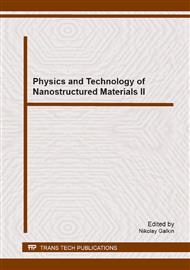[1]
X. -Q. Zhao, H. -D. Zhou, J. -M. Chen, Comparative study of the friction and wear behavior of plasma sprayed conventional and nanostructured WC–12%Co coatings on stainless steel, Mater. Sci. Eng. A. 431 (2006) 290–297.
DOI: 10.1016/j.msea.2006.06.009
Google Scholar
[2]
E.I. Zamulaeva, E.A. Levashov, A.E. Kudryashov, P.V. Vakaev, M.I. Petrzhik, Electrospark coatings deposited onto an Armco iron substrate with nano- and microstructured WC–Co electrodes: Deposition process, structure, and properties, Surf. Coat. Technol. 202 (2008).
DOI: 10.1016/j.surfcoat.2008.01.008
Google Scholar
[3]
M. Guilemany, S. Dosta, J. Nin, J.R. Miguel, Study of the Properties of WC-Co Nanostructured Coatings Sprayed by High-Velocity Oxyfuel, J. Therm. Spray Technol. 14 (2005) 405–413.
DOI: 10.31399/asm.cp.itsc2005p0530
Google Scholar
[4]
Q. Yang, T. Senda, A. Ohmori, Effect of carbide grain size on microstructure and sliding wear behavior of HVOF-sprayed WC-12% Co coatings, Wear. 254 (2003) 23–34.
DOI: 10.1016/s0043-1648(02)00294-6
Google Scholar
[5]
M. Jalali Azizpour, S. Norouzi, H. Mohammadi Majd, H. Talebi, A. Ghamari, Application of HVOF Thermal Spraying in High Speed Gas Compressor Shafts, Sci., Eng. Technol. 69 (2010) 360–362.
Google Scholar
[6]
J. Liu, R. Wang, Y. Qian, Formation of a single-pulse electrospark deposition spot, Surf. Coat. Technol. 200 (2005) 2433–2437.
DOI: 10.1016/j.surfcoat.2004.07.104
Google Scholar
[7]
J. Wang, H. Meng, H. Yu, Z. Fan, D. Sun, Wear. Characteristics of Spheroidal Graphite Roll WC-8Co. Coating Produced by Electro-Spark Deposition, Rare Met. 29 (2) (2010) 174–179.
DOI: 10.1007/s12598-010-0030-6
Google Scholar
[8]
V.S. Panov, A.M. Chuvilin, Technology and properties of sintered hard alloys, MISA, Moscow, 2001, p.452 (in Russian).
Google Scholar
[9]
Y. Kusano, K V. Acker, I.M. Hutchings, Methods of data analysis for the micro-scale abrasion test on coated substrates, Surf. Coat. Technol. 183 (2004) 312–327.
DOI: 10.1016/j.surfcoat.2003.10.010
Google Scholar
[10]
W. Żórawski, The microstructure and tribological properties of liquid-fuel HVOF sprayed nanostructured WC–12Co coatings, Surf. Coat. Technol. 220 (2013) 276–281.
DOI: 10.1016/j.surfcoat.2012.11.007
Google Scholar
[11]
C. Bartuli, T. Valente, F. Cipri, E. Bemporad, M. Tului, Parametric study of an HVOF process for the deposition of nanostructured WC-Co coatings, J. Therm. Spray Technol. 14 (2005) 187–195.
DOI: 10.1361/10599630523746
Google Scholar
[12]
M. Wang, R. Pan, S. Li, X. Lei. Effect of freezing point and surface roughness on coating by electro-spark deposition, Proc. 2012 Int. Conf. Mechanical Engineering and Material Science (MEMS 2012), Atlantis Press, p.21–24.
DOI: 10.2991/mems.2012.7
Google Scholar
[13]
T. Sudaprasert, P.H. Shipway, D.G. McCartney, Sliding wear behaviour of HVOF sprayed WC–Co coatings deposited with both gas-fuelled and liquid-fuelled systems, Wear 255 (2003) 943–949.
DOI: 10.1016/s0043-1648(03)00293-x
Google Scholar


